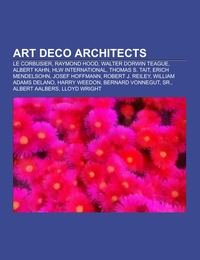-
Zusatztext
-
Source: Wikipedia. Pages: 59. Chapters: Le Corbusier, Raymond Hood, Walter Dorwin Teague, Albert Kahn, HLW International, Thomas S. Tait, Erich Mendelsohn, Josef Hoffmann, Robert J. Reiley, William Adams Delano, Harry Weedon, Bernard Vonnegut, Sr., Albert Aalbers, Lloyd Wright, Wolff Schoemaker, Claud Beelman, Oliver Percy Bernard, Wirt C. Rowland, Percy Edgar Everett, Kurt Vonnegut, Sr., Charlotte Perriand, Pablo Antonio, Ralph Thomas Walker, Ernest Cormier, David Evelyn Nye, Arthur Bohn, Paul T. Frankl, Vonnegut & Bohn, Abraham E. Lefcourt, Ralph Oscar Yeager, George Caleb Wright, Stiles O. Clements, Vonnegut, Wright & Yeager, Joseph Sunlight, Chester Holmes Aldrich, John M. Donaldson, Harry D. Payne, Ludger Lemieux, Gordon Kaufmann, Miller & Yeager, Louis Hay, Alfred Hahn, Victor Nellenbogen, John Augur Holabird, Arthur T. Brown, John Wellborn Root, Jr., Martin Roche, Pierre & Wright, Albert Lothian, Albert Anis, George Coles, John Lloyd Wright, Giuseppe Pettazzi. Excerpt: Charles-Édouard Jeanneret, better known as Le Corbusier (French pronunciation:; October 6, 1887 - August 27, 1965), was a Swiss-born French architect, designer, urbanist, writer and painter, famous for being one of the pioneers of what now is called modern architecture. He was born in Switzerland and became a French citizen in 1930. His career spanned five decades, with his buildings constructed throughout central Europe, India, Russia, one in North and several in South America. He was a pioneer in studies of modern high design and was dedicated to providing better living conditions for the residents of crowded cities. Le Corbusier adopted his pseudonym in the 1920s, allegedly deriving it in part from the name of a distant ancestor, "Lecorbésier." However, it appears to have been an earlier (and somewhat unkind) nickname, which he simply decided to keep. He was awarded the Frank P. Brown Medal in 1961. He was born as Charles-Édouard Jeanneret-Gris in La Chaux-de-Fonds, a small city in Neuchâtel canton in north-western Switzerland, in the Jura mountains, just 5 kilometres (3.1 mi) across the border from France. He attended a kindergarten that used Fröbelian methods. Young Jeanneret was attracted to the visual arts and studied at the La-Chaux-de-Fonds Art School under Charles L'Eplattenier, who had studied in Budapest and Paris. His architecture teacher in the Art School was the architect René Chapallaz, who had a large influence on Le Corbusier's earliest houses. In his early years he would frequently escape the somewhat provincial atmosphere of his hometown by traveling around Europe. About 1907, he traveled to Paris, where he found work in the office of Auguste Perret, the French pioneer of reinforced concrete. In 1908, He studied architecture in Vienna with Josef Hoffmann. Between October 1910 and March 1911, he worked near Berlin for the renowned architect Peter Behrens, where he might have met Ludwig Mies van der Rohe and Walter Gropius. He became fluent in Ger
-
Detailansicht
Art Deco architects
Le Corbusier, Raymond Hood, Walter Dorwin Teague, Albert Kahn, HLW International, Thomas S.Tait, Erich Mendelsohn, Josef Hoffmann, Robert J.Reiley, William Adams Delano, Harry Weedon, Bernard Vonnegut, Sr., Albert Aalbers, Lloyd Wright
ISBN/EAN: 9781155318691
Umbreit-Nr.: 4322768
Sprache:
Englisch
Umfang: 60 S.
Format in cm: 0.4 x 24.6 x 18.9
Einband:
kartoniertes Buch
Erschienen am 03.01.2013
Auflage: 1/2013


